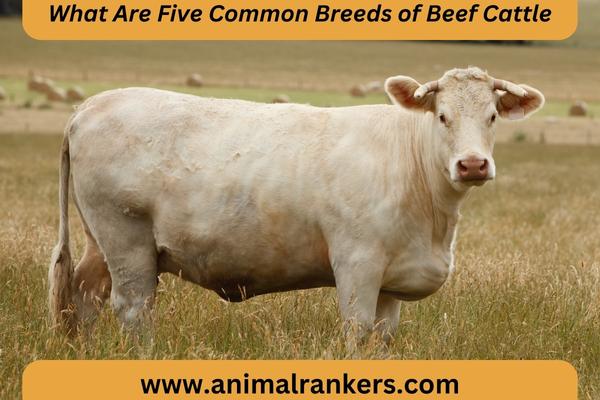Five Common Breeds of Beef Cattle
Raising beef cattle for meat production is a major industry worldwide. There are over 800 different breeds of cattle, but only a handful are regularly used in commercial beef production.
The most common beef cattle breeds have been selectively bred over decades or even centuries to optimize traits like fast growth rates, efficient feed-to-meat conversion, and high-quality beef.
Understanding the unique qualities of popular beef cattle breeds can help farmers and ranchers select the right animals for their operations.
In this blog article, we will explore five of the most ubiquitous beef cattle breeds raised worldwide.
1. Angus Cattle

Of all beef breeds, Black Angus cattle dominate the North American beef industry. Native to Scotland, they are naturally polled (without horns) and solid black, though a recessive gene can produce red coats. Angus are prized for producing flavorful, abundantly marbled beef.
Key traits:
- Excellent marbling and meat quality
- Good maternal instincts and calving ease
- Adaptability to varied environments
- Docile temperament
Angus beef often demands premium prices, as the breed has one of the highest USDA meat quality grades. Angus cattle mature early and are easy calvers, making them suitable for first-time cattle producers.
2. Hereford Cattle

Herefords originated as dual-purpose draft animals in Herefordshire, England. They have distinctive red bodies and white faces, with fast growth rates. Their muscular builds and ability to thrive on grass make Herefords ideal for grazing operations.
Key traits:
- High fertility rates and calving ease
- Hardy constitution on pasture or rangeland
- Fast weight gain on grass
- Docile dispositions
Herefords adapt well to varied climates and terrains. While not as marbled as Angus, Hereford beef is still tender and delicious. The breed helped build the cattle industry across North and South America.
3. Simmental Cattle

Originating in the Simme Valley of Switzerland, Simmentals are the second most numerous beef breed worldwide. They are large, muscular cattle recognized by their reddish-brown coats with white markings on the face, legs, belly, and tail tip.
Key traits:
- High growth rates and excellent feed conversion
- Lean, heavily muscled carcasses
- High fertility and milk production
- Calm temperament
Simmental bulls have been used widely in crossbreeding programs to transmit growth efficiency to other breeds. While purebred Simmentals produce rather lean beef, crossbred Simmental calves generate nicely marbled carcasses ideal for meat markets.
4. Charolais Cattle

Developed in west-central France, Charolais are the lightest-colored breed of beef cattle, with white to cream coats setting them apart.
Their extremely rapid growth, combined with heavily muscled frames, makes the Charolais a terminalsire of choice for producing beefy crossbred calves.
Key traits:
- Very fast lean growth
- Heavy muscling and meat yield
- Large mature size
- Relative calving difficulty
Charolais bulls breed relatively large calves, so they are often mated to cows with ample birthing hips. While purebred French Charolais beef can be almost too lean, using Charolais genetics on British-bred cows results in nicely balanced, quick-growing calves with decent marbling.
5. Brahman Cattle

Brahman cattle originated in the hot, harsh environments of India. Prized for heat tolerance and insect resistance, Brahmans have loose, greyish skin and large droopy ears. They are used purebred or crossed with European breeds mainly in subtropical regions.
Key traits:
- Extremely hardy constitution
- Calving ease
- Parasite and disease resistance
- Foraging ability
Brahmans thrive on low-quality roughage in extremely hot, humid climates that would devastate other breeds. They confer these adaptive traits to crossbred offspring. Brahman beef tends to be low marbled, so carcasses are often blended with higher grading beef.
Choosing Cattle for Your Operation
When selecting beef cattle, carefully consider your climate, facilities, feed resources, breeding goals, target markets, and business model.
While exotic breeds offer advantages like rapid growth or grass-based gained, local environmental adaptability is also key. Heritage breeds with proven longevity in your area can be a wise choice for beginning cattle owners.
Work with extension agents or state breed associations to learn the strengths of regional cattle breeds. By choosing the right genetics for your conditions and management style, you can optimize herd productivity and profitability.
Consider crossbreeding complementary breeds to unite the best traits of both into an animal tailored to your specific needs.
The Most Common Beef Cattle Breeds
- Angus cattle are the most popular beef breed due to their efficient muscling and abundant marbling for fine-flavored beef.
- Herefords offer fertility, grazing ability, hardiness and good dispositions.
- Fast-growing Simmentals boast excellent feed efficiency and have been used extensively in crossbreeding schemes worldwide.
- Charolais are terminal sires known for heavy muscling and rapid lean growth potential.
- Brahman genetics confer heat tolerance and insect resistance required in hot, humid climates.
By understanding the major types of beef cattle, cattle producers can select breeds or create crossbreeds ideal for their particular ranching environments and beef production goals.


